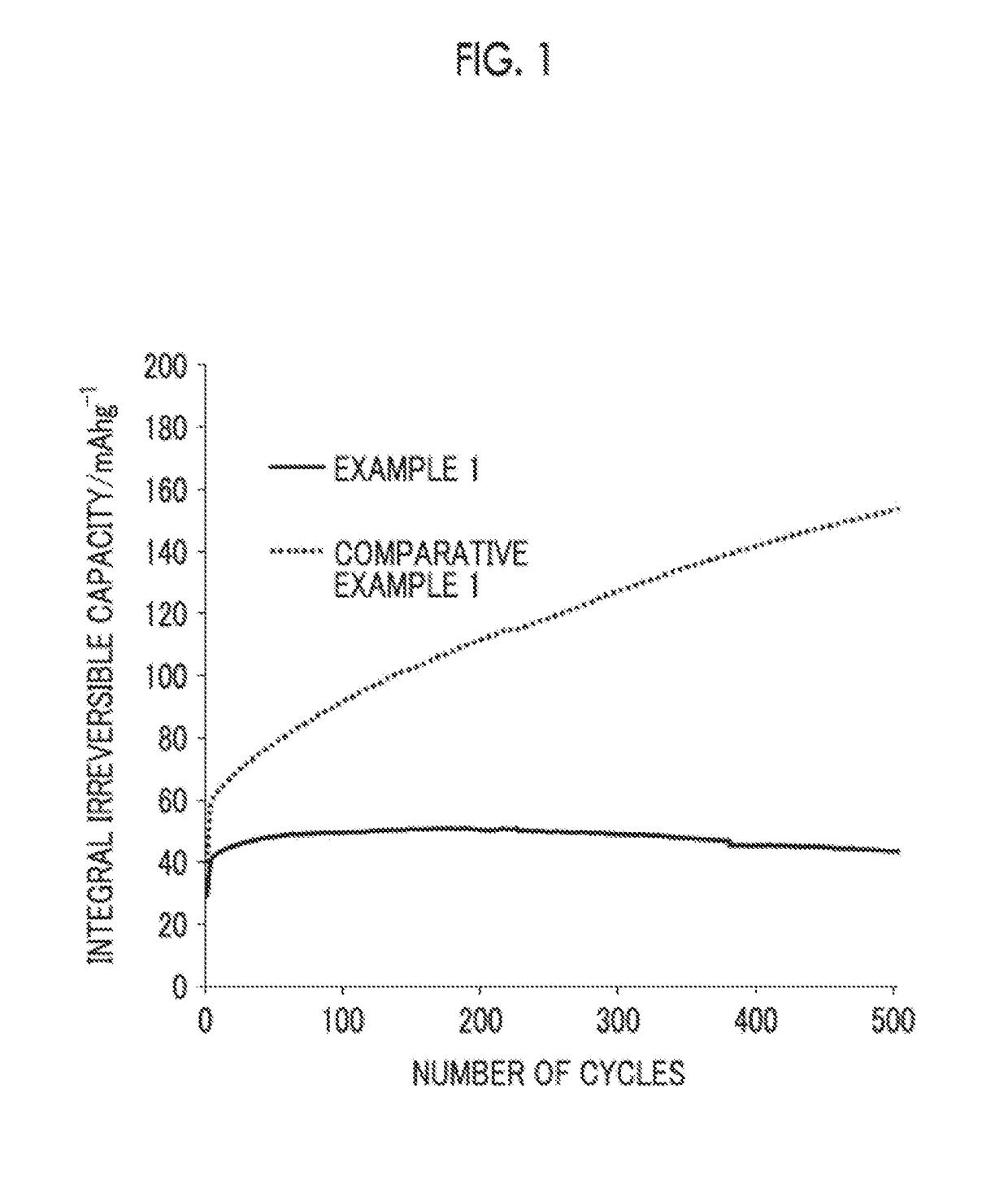Lithium-ion secondary battery
a secondary battery and lithium-ion technology, applied in the field of lithium-ion secondary batteries, can solve the problems of inability to control the degradation of long-term cycle characteristics, and achieve the effect of excellent long-term cycle characteristics
- Summary
- Abstract
- Description
- Claims
- Application Information
AI Technical Summary
Benefits of technology
Problems solved by technology
Method used
Image
Examples
example 1
[0168]Synthesis of Cathode Active Material Particles
[0169]Lithium phosphate (Li3PO4) (2 mol) and iron (II) sulfate (FeSO4) (2 mol) were mixed into water (2 L (liters)) so that the total amount reached 4 L (liters), thereby preparing a homogeneous slurry-form mixture. The obtained mixture was stored in a pressure-resistant airtight container having a capacity of 8 L (liters) and was hydrothermally synthesized at 180° C. for one hour, thereby generating a precipitate. The obtained precipitate was washed with water, thereby obtaining a cake-form precursor of cathode active material particles.
[0170]Next, a polyethylene glycol (5.5 g) as the organic compound and zirconia balls (500 g) having a diameter of 5 mm as medium particles were mixed into this precursor of the cathode active material particles (150 g in terms of solid contents), and a dispersion treatment was performed in a ball mill for 12 hours, thereby preparing a homogeneous slurry. The prepared slurry was sprayed in the atmos...
example 2
[0186]Synthesis of Cathode Active Material Particles
[0187]Cathode active material particles A2 of Example 2 were obtained in the same manner as in Example 1.
[0188]Synthesis of Inorganic Phosphate Particles
[0189]Inorganic phosphate particles B2 of Example 2 were obtained in the same manner as in Example 1.
[0190]Mixing of Cathode Active Material Particles and Inorganic Phosphate Particles
[0191]The cathode active material particles A2 and the inorganic phosphate particles B2 were uniformly mixed together so that the mass of the inorganic phosphate particles B2 with respect to the cathode active material particles A2 (100 parts by mass) reached 1 part by mass, and the obtained powder was considered as a cathode material for a lithium-ion secondary battery of Example 2 (cathode material C2).
[0192]Production of Lithium-Ion Secondary Battery
[0193]A lithium-ion secondary battery of Example 2 was produced in the same manner as in Example 1 except for the fact that the cathode material C2 of ...
example 3
[0194]Synthesis of Cathode Active Material Particles
[0195]Cathode active material particles A3 of Example 3 were obtained in the same manner as in Example 1.
[0196]Synthesis of Inorganic Phosphate Particles
[0197]Phosphoric acid (H3PO4) (0.5 mol) and lithium carbonate (Li2CO3) (0.75 mol) were mixed into water (500 mL (milliliter)), thereby preparing a homogeneous slurry-form mixture. The prepared mixture was heated at 150° C. for one night so as to evaporate moisture, thereby drying the mixture. The dried mixture was calcinated in the atmosphere at 600° C. for 12 hours, thereby obtaining inorganic phosphate particles made of Li3PO4.
[0198]Next, the obtained inorganic phosphate particles were classified using a stainless steel sieve having a mesh of 45 μm, thereby obtaining Li3PO4 having a particle diameter of 45 μm or less (inorganic phosphate particles B3).
[0199]The average primary particle diameter of the inorganic phosphate particles B3 was 27 μm.
[0200]Mixing of Cathode Active Mater...
PUM
 Login to View More
Login to View More Abstract
Description
Claims
Application Information
 Login to View More
Login to View More - R&D Engineer
- R&D Manager
- IP Professional
- Industry Leading Data Capabilities
- Powerful AI technology
- Patent DNA Extraction
Browse by: Latest US Patents, China's latest patents, Technical Efficacy Thesaurus, Application Domain, Technology Topic, Popular Technical Reports.
© 2024 PatSnap. All rights reserved.Legal|Privacy policy|Modern Slavery Act Transparency Statement|Sitemap|About US| Contact US: help@patsnap.com








